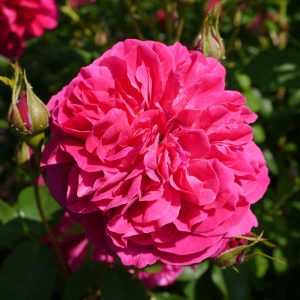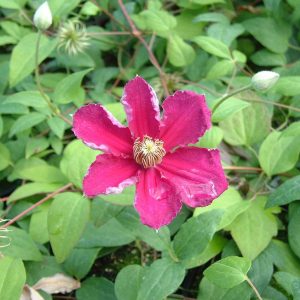Description
Rheum x hybridum ‘Ever Red’ is a striking perennial plant known for its large, colourful foliage and red stems. It belongs to the family Polygonaceae and is a cross between two species of rhubarb. ‘Ever Red’ is a robust plant that grows up to 1 meter in height and spread. Its large leaves are heavily veined and range in colour from dark green to deep burgundy. The plant produces tall spikes of small greenish-white flowers in early summer, but it is primarily grown for its decorative foliage. This plant prefers a well-drained soil and partial to full sun exposure. It is relatively low maintenance, and regular watering and fertilization will promote healthy growth. The stalks of ‘Ever Red’ can be harvested and used for culinary purposes, just like traditional rhubarb. However, it is important to note that the leaves are toxic and should not be consumed.
Key Facts
- Common Name(s):Rhubarb ‘Ever Red’
- Hardiness:Fully hardy
- How big will I get? Rheum x hybridum ‘Ever Red’ can grow to a height of 1m and a spread of 1m.
- Did You Know That:Rheum x hybridum is a cross between Rheum rhabarbarum (edible rhubarb) and Rheum palmatum (Chinese rhubarb)?
Plant Calendar
A rough guide to how this plant will change through the year.
| Jan | Feb | Mar | Apr | May | June | July | Aug | Sept | Oct | Nov | Dec | |
| Foliage Colour |   |
  |
  |
 |
 |
 |
 |
 |
 |
| J | F | M | A | M | J | J | A | S | O | N | D |
  |
  |
  |
 |
 |
 |
 |
 |
 |
Care Guide

Soil Requirements
Rheum x hybridum ‘Ever Red’ prefers moist but well-draining soil. This plant can grow in soil with a wide range of pH levels, it is not picky about the pH level of the soil.

Best Position
Rheum x hybridum ‘Ever Red’ prefers a sheltered position and requires full sun to thrive, this consists of more than six hours of direct sunshine per day.

Maintenance
Rheum x hybridum ‘Ever Red’ can be trimmed back as soon as any flowerheads start to develop. Any remaining foliage will die back in Autumn, but any remaining foliage can be cut back just before the start of Winter.

Pest, Diseases and Wildlife
Rheum x hybridum ‘Ever Red’ can have problems with aphids, slugs and snails, it can be vulnerable to certain diseases such as virus’. It is not considered to be toxic.





